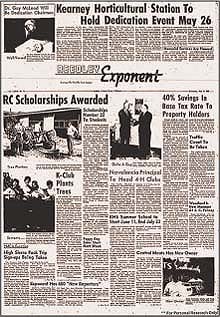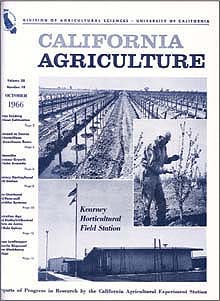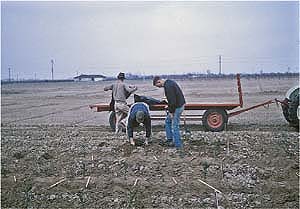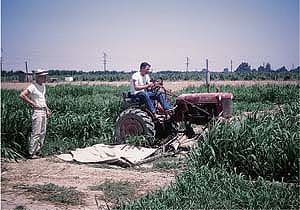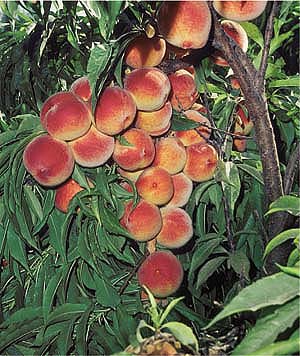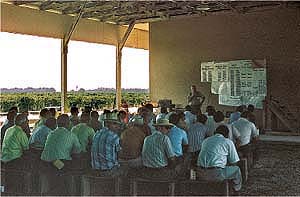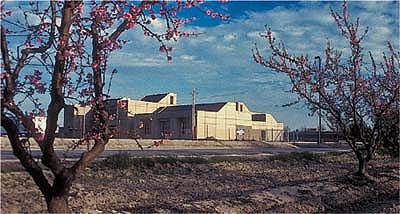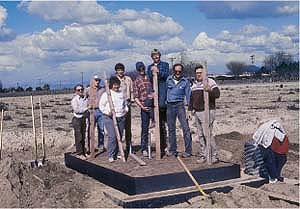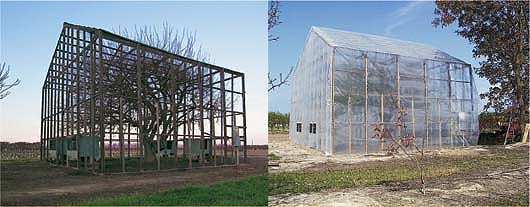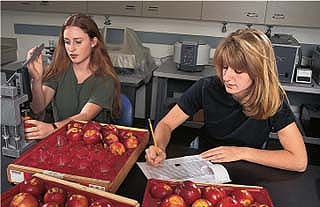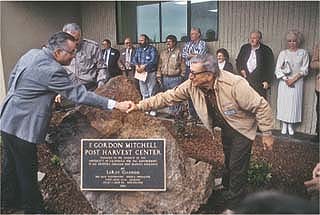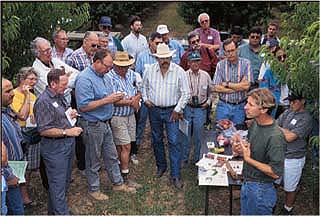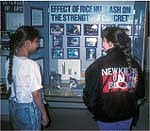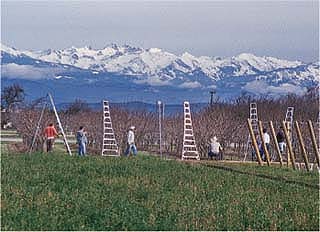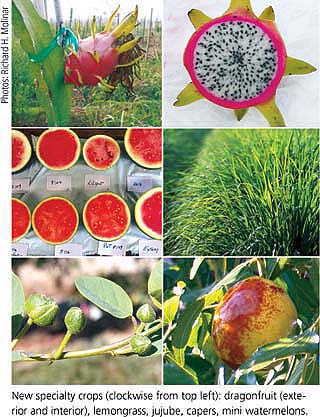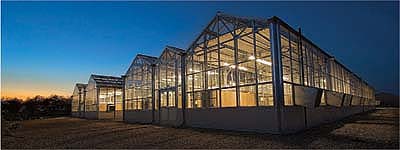All Issues
Agricultural innovation marks 40 years at Kearney
Publication Information
California Agriculture 59(2):56-61.
Published April 01, 2005
PDF | Citation | Permissions
Full text
1962 UC purchases the 195-acre Mosesian Ranch
Brother Norbert blesses the Mosesian Ranch at the 1964 groundbreaking; with bowed head is Guy F. “Doc” MacLeod, entomologist and chair of Board of Trustees for the M. Theodore Kearney Horticultural Field Station.
What stated 40 years ago as an old ranch at the heart of the San Joaquin Valley is today a world-class research operation, from which flows a steady stream of practical ideas and solutions ready for implementation by the region's farmers.
The UC Kearney Research and Extension Center (KREC) has advanced understanding of every aspect of production and environmental management related to the valley's bounty of fruits, vegetables and field crops. It is no coincidence that Kearney is located in what has become the state's number-one agricultural county, on land that is some of the most productive in the world.
With 24 resident faculty conducting basic as well as field research, the center is like a mini-campus, with 33 specialized research laboratories and 100 laboratory staff members. It also serves more than 100 off-station scientists from three UC campuses and Cooperative Extension offices. Not surprisingly, it is the most utilized off-campus agricultural research facility in the UC system. In addition, more than 6,000 people a year visit the center or participate in its meetings, workshops, field days and seminars.
Kearney's 330 acres of research facilities encompass a new state-of-the-art greenhouse, a postharvest laboratory, a mosquito control laboratory, multiple insectaries, and academic and administrative offices. Its controlled field studies occupy 260 acres of orchards, vineyards and fields.
KREC scientists have developed novel cultivation, pruning and planting methods for the major valley crops, while at the same time introducing newer specialty crops like blueberries and Asian eggplant. Kearney has also been one of the key testing grounds for sustainable farming methods, such as integrated pest management (IPM), biological control, water conservation and nitrogen management.
“As growers, we are dealing with new invasive pests, clean air and water regulations, the need to reduce labor costs, and the search for alternatives to methyl bromide,” says Bill Chandler, who farms in the Selma area and is active in KREC committees. “We look to Kearney for sound science to help agriculture grow and thrive.”
Turn-of-the-century origins
UC has supported off-campus research sites for more than a century. In the 1880s, UC Berkeley professor Eugene Hilgard established a 20-acre field station southeast of Tulare for variety tests and work on the reclamation of alkali soils. Kearney's origins go back to the turn of the 20th century, when prominent developer M. Theodore Kearney willed his 5,400-acre estate west of Fresno to the University for educational purposes. UC sold the land, generating revenue to establish the Kearney Foundation, which later would supply matching funds for a research center named in Kearney's honor.
In the early 1960s, the San Joaquin Valley was fertile ground for the expansion of agricultural science and technology. However, prominent San Joaquin Valley agriculturists knew that problems peculiar to the valley could “tarnish the bright potential of this unique farming area,” according to noted banker and agricultural economist Jesse Tapp (Reedley Exponent, June 2, 1965). Challenges included irrigation management, alkali soils, pests and diseases, evaluating new tree and vine varieties, and developing rootstocks with resistance to nematodes and disease.
1964 Groundbreaking for two houses, an office, a laboratory and machine-storage and equipment-repair building
1965 Formal dedication of the Kearney Horticultural Field Station, May 26
1966 Additional 30 acres purchased
1969 $165,000 contract awarded to build a 97-by-100-foot building with 14 offices, laboratories and conference room
KREC director Fred Swanson credits Tapp and other midcentury valley agriculturalists for their prophetic understanding that investing in regional agricultural infrastructure would reap great rewards. “These visionaries knew that the valley was a unique production area and that agricultural research needed to be local, relevant and accessible,” Swanson says.
In 1959 the Fresno County Farm Bureau took the lead in forming the San Joaquin Valley Fruit and Grape Station Trust, which collected contributions from farmers, fruit packers, agricultural suppliers and others. Gifts ranging from $2 to $10,000 amounted to $128,500 to match Kearney Foundation funds. After serious consideration of several sites, a committee suggested the Mosesian Ranch, a uniform alluvial plain with favorable sandy loam soil. UC consented and the 195-acre Mosesian Ranch, at the intersection of Manning and Riverbend avenues between the cities of Reedley and Parlier, was purchased on Aug. 12, 1962.
Officials broke ground nearly 2 years later on two houses, a laboratory and a building for machinery storage and equipment repair. A year later, on May 26, 1965, the Kearney Horticultural Field Station was formally dedicated with several hundred spectators on hand, according to newspaper accounts. Visitors took tours to see research plantings of tea, grapes, peaches, plums, olives, nectarines, almonds, walnuts and other crops that were already under way.
In the following four decades, the center steadily grew to accommodate new research needs, reflecting the region's rapidly expanding and changing agricultural economy. In 1985, the last 65 acres of land was purchased, bringing the total acreage to the present 330.
Meanwhile, the Kearney center expanded its outreach. Educational programs have attracted hundreds of elementary through college-level students in recent years, including those attending science and career fairs, and agricultural tours.
Kearney scientists advance IPM
Kearney research over the decades has linked UC faculty to “on the ground” problems. Interacting closely with growers, UC scientists developed innovations, including new pest management technologies.
The low price and effectiveness of pesticides available to farmers after World War II led to their acceptance as normal and automatic, setting off a ripple of developments. Farmers, farm advisors and specialists began observing pest resistance and long-term pesticide residuals on farms and in the environment. In other areas, they witnessed the phenomena of biological control when, without any pesticide treatment, a pest population would spontaneously disappear. Scientific evaluation revealed natural pest predators at work. In the 1950s, the campus-based scientists, researchers in the valley, farm advisors and specialists began making connections. They studied the concepts of “integrated control” and “economic thresholds” and soon, just as research at Kearney was hitting its stride, “integrated pest management” was born.
1970 New building is completed
1972 Added another 40 acres
1973 Added biological control unit with quarantine laboratory, one of five in the United States
1977 Capital improvements included five office-laboratory trailers, fruit and vegetable handling lab, volatile storage building, two greenhouses, one potting shed and one storage building
UC mosquito research was conducted in Fresno throughout the 1970s; the lab moved to Kearney in early 1984.
“Pioneering work in integrated pest management for California tree crops was conducted at Kearney,” says Frank Zalom, a Cooperative Extension entomologist and former director of the UC Statewide IPM Program. In particular, Zalom credits retired Kearney-based entomologist Richard Rice and colleagues with the successful development of pheromone trapping, “degree day” models that predict the growth of common stone fruit pests such as San Jose scale and peach twig borer, and egg traps for the navel orangeworm, the most important insect pest of almonds.
Kearney entomologists, plant pathologists and nematologists have worked to minimize pesticide use and utilize reduced-risk products for pest control. For instance, they advanced the use of plastic reflective mulch to repel aphids that spread viruses, reducing virus disease incidence up to 80% ( see page 90 ). “This level of disease reduction assures an acceptable product for the grower who might otherwise be unable to make a profit,” says Charles Summers, a UC Davis entomologist based at Kearney.
Other advances include the development of rapid molecular assays to detect microscopic fungal spores, as well as their resistance to fungicides. This could save growers millions of dollars in unneeded fungicide applications, while reducing environmental damage from pesticide runoff ( see page 115 ). Also, spurred by the ban of the nematicide DBCP in 1979, Kearney research advanced the understanding of how root growth timing and patterns could help identify best nematode treatments ( see page 63 ).
Focus on fruits, nuts and grapes
While working to combat crop pests in environmentally sensitive ways, UC scientists have also used Kearney as a laboratory to dramatically improve the economics of growing perennial crops by focusing on varietal improvements and cultivation techniques. From the beginning, deciduous fruits, nuts and grapes were the agricultural focus at the Kearney Horticultural Field Station.
Over the years, numerous vineyards were planted at Kearney to conduct experiments on table, raisin and wine grapes. Scientists have found, for example, that excellent varietal wines can be produced in the valley's hot, dry conditions. Numerous table grape varieties were studied for optimum farming practices. Scientists here identified the raisin varieties and trellis systems that are most conducive to dried-on-vine (DOV) raisin production, which could result in substantial savings to growers as well as significant improvements in air quality ( see page 70 ).
1985 Added parcel across Riverbend Avenue, bringing total acreage to 330
1986 Weighing lysimeters installed
1989 Dedicated new office and laboratory building
May 29, 1987, groundbreaking for the new building at Kearney. Left to right: State Senator Rose Ann Vuich, Lowell Lewis (Associate Director of Agricultural Experiment Station), Dick Markarian (California Raisin Bargaining Association), Fresno County Supervisor Vernon Conrad, State Assemblyman Bill Jones, Ken Farrell (Vice President, UC Division of Agriculture and Natural Resources), Leo S. Kolligian (UC regent) and mule skinner Bob Simmons on a Fresno scraper, with two show mules.
Today, California produces nearly 60% of the nation's peaches, and the region is a significant producer of plums, dried plums, apricots, almonds, pistachios and other commodities. UC scientists have increased understanding of stone fruit nutrition, water needs, pest and disease management, pruning and postharvest handling. For instance, they developed high-density pruning systems that have become the industry standard ( see page 75 ).
“The advantage of high-density systems is that you get early production. In the third, fourth and fifth year, you can get much more fruit per acre than an open-vase orchard of the same age,” says Kearney-based pomologist R. Scott Johnson. A successful high-density pruning system has taken the name “Kearney” worldwide. In addition to California, the system is popular in Australia, Chile, Europe and Canada.
Grower groups such as the California Tree Fruit Agreement (CTFA) provide active support and collaboration. Representing about 1,500 stone fruit growers, three-quarters of whom live within 60 miles of KREC, CTFA provides substantial funding support for Kearney research into rootstock development, orchard design, water management, IPM and postharvest physiology. “It's really important to have this facility close by,” says Gary Van Sickle, CTFA's director of research. “Our growers don’t have time for trial and error, and the center is just a few miles away. We hold a lot of field days so growers can see how to best apply the research results.”
Legendary “mother” pistachio tree to be retired
Left, the dormant tree can be seen through open framework. Right, a frame covered with plastic protects the tree from outside pollen during bloom period.
Always a curiosity to Kearney visitors is an extra large pistachio tree growing within a huge wooden frame. In the spring, the scaffolding in this frame supports a plastic cover that allows this “mother tree” to be hand-pollinated.
It was planted as part of a variety block of pistachios at KREC by now-retired UC Cooperative Extension pomologist Carl Optiz. The female parent tree, Pistacia atlantica, was crossed in 1980 with a male Pistacia integerrima in the same block by Lee Ashworth in the UC Berkeley Department of Plant Pathology.
The resulting rootstock produces the highest yields of any pistachio rootstock in California and has an optimal combination of tolerance to cold, salinity and Verticillium wilt. “This means the California pistachio industry can be extended into areas previously thought too cold for other rootstocks,” says Cooperative Extension pomologist Louise Ferguson. “More importantly, trees can be planted in soils not suitable for any other fruit or nut tree in California, except dates, and irrigated with sub-par water quality.
This rootstock is now in extensive use in the lower west side of the Central Valley. Because the Foundation Plant Materials Service produces seed of this cross and budwood has been propagated by private source, Kearney's will be retired later this year and the scaffolding removed.
“But, like a good mother,” Ferguson says, “she’ll always be there.”
— John Stumbos
1992 Dedicated F. Gordon Mitchell Post Harvest Center
1999 Renamed the UC Kearney Research and Extension Center
Unique setting fosters innovation
Swanson says that what makes Kearney unique is its mixture of scientists, extension specialists and research technicians linked to three UC campuses and their many different departments. “There's a critical mass here of knowledge and experience that is a catalyst for creative thought and imagination,” he says. “At any one time up to 90 different research studies are under way on about 50 crops in the fields, labs and greenhouses.”
One of the station's newest additions is a 20,000-square-foot, $2.9 million greenhouse, completed in 2004, which offers 24 individual plant-growing modules, computer-controlled for temperature and humidity for year-round research. There are now 18 greenhouse projects exploring the biology and control of insect and fungal diseases, pest-resistant plant selection, the impact of ozone on crop production, and specialty crop evaluation.
Always a curiosity to Kearney visitors is an extra-large pistachio tree growing within a huge wooden frame. During the bloom period, the frame supports a plastic cover that protects the tree from collecting airborne pollen. Instead, the tree is painstakingly hand-pollinated and the nuts carefully harvested (). The frame also supports netting in the fall to protect the nuts from scavenging birds.
In another unusual undertaking, Johnson installed sixty 6-by-12-foot tanks 4-feet deep on a research plot and filled each one with 19,000 pounds of sand. He planted a plum tree, yellowflesh peach tree and white-flesh nectarine tree in each tank. The sand supports the trees but supplies no nutrients, permitting scientists to carefully measure and apply all the nutrients for tree development. This is the definitive global study on peach, plum and nectarine nutrition, Johnson says, and is also the first nutritional study ever done on white-fleshed fruit, which now makes up 20% to 25% of the California industry.
As early as 1986, the University constructed two huge underground scales on the west side of Riverbend Avenue. Called weighing lysimeters, the apparatuses — one planted with grapevines, the other with peach trees — have allowed scientists to calculate precisely how much water evaporates from the soil and transpires from the tree at any given time ( see page 133 ). “There are very few of these in the world large enough for trees and vines,” Johnson says. With knowledge about plant water use gleaned from lysimeter studies, scientists are better prepared to provide science-based information to farmers facing any water problem.
2004 New greenhouse facility dedicated
2005 Kearney marks 40 years
New specialty crops (clockwise from top left): dragonfruit (exterior and interior), lemongrass, jujube, capers, mini watermelons.
“Niche” crops keep small farms afloat
Kearney has also taken a leading role in developing new specialty and “niche” crops that are well suited for the valley's small-scale growers. Grape tomatoes, a popular item replacing cherry tomatoes, mini “personal” watermelons, and pitahaya or dragon fruit are being studied at Kearney in trials by UCCE farm advisor Richard H. Molinar and colleagues. His plots also feature capers, jujube tree, lemon grass, water chestnuts and other plants.
Near the eastern boundary of the research station, UCCE farm advisor Manuel Jimenez maintains 21 varieties of blueberry plants entering their eighth year of production ( see page 65 ). Long considered unsuitable to San Joaquin soils and climate, blueberries are now plentiful in Tulare and Fresno counties due to studies by Jimenez and colleagues on southern highbush varieties and methods of keeping the plant in its preferred low-pH environment. “We have one variety that's just exceptional,” Jimenez says. “The taste is far superior to any I have ever tried and the texture is perfect.”
Farming at the urban edge
The San Joaquin Valley is undergoing tremendous population growth, which is altering how farmers ply their trade and interact with their urban neighbors. In addition, the resulting air pollution is affecting crop yields and weed interactions. On a research plot west of Riverbend, open-top field chambers allow UC Riverside plant physiologist David Grantz and colleagues to study the effects of different levels of ozone on plant development ( see page 137 ). As early as 1971, William B. Hewitt, who served as director of the San Joaquin Valley Agricultural Research and Extension Center at Kearney from 1969 to 1974, cautioned that urban growth in the valley must consider the importance of the area's agricultural potential.
“Geographically this valley is a basin over which air inversion phenomena is common and thus traps air pollutants,” he was quoted in a 1971 Reedley Exponent article. “We can not have developments that add to air pollution problems.”
Urban growth continues to be an agricultural concern. The valley has changed dramatically during the past 40 years. In a 2005 report, the Public Policy Institute of California predicted that the valley population will double to more than 7 million by 2045. The institute's experts say that doesn’t portend the demise of valley farming, but it does apply pressure to sell farmland for development prices, grow crops on less space and farm closer to urban populations.
“If we, as growers and packers, are to survive and compete in a global agricultural economy, we need Kearney's continued assistance,” Chandler says. “With their help, we can become more efficient and productive, and continue to produce the safest and most affordable food in the world.”





